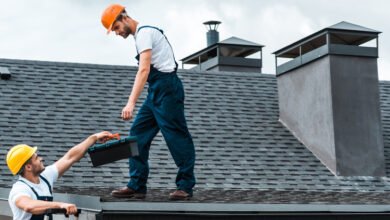Rolled Roofing for DIY Homeowners Everything You Need to Know

When it comes to roofing materials, rolled roofing is one of the most practical and cost-effective options available. Its simplicity and affordability make it particularly attractive to DIY enthusiasts looking to save on professional installation costs.
But what exactly is rolled roofing, and is it the right choice for your project? This guide will answer all your questions, equip you with the knowledge to install it yourself, and provide tips to ensure success.
What Is Rolled Roofing?
Rolled roofing, also known as “rolled roof material,” is a mineral-surfaced roofing fabric designed for low-slope roofs. Unlike traditional shingles that come in small pieces, rolled roofing is sold in large rolls. Each roll typically covers an area of 100 square feet, making it ideal for projects where efficiency is key.
Types of Rolled Roofing Materials
There are a few common types of rolled roofing materials you might come across:
- Asphalt-Saturated Felt: Affordable but not as durable.
- Mineral-Surfaced Rolled Roofing: Popular for its weather-resistant coating.
- Rubber Rolled Roofing (EPDM): Flexible, durable, and perfect for flat roofs.
- Fiberglass Rolled Roofing: Lightweight but effective in covering areas.
Each type has pros and cons, so choosing the right one for your project depends on its specific needs.
See also: Unexpected Industries Hiring CompTIA Network+ Certified Pros(Hint: It’s Not Just Tech Companies)
Why Rolled Roofing Is Perfect for DIY Homeowners
Rolled roofing has a reputation for being straightforward, making it a great choice for DIY homeowners.
Cost-Effective Solution
If you’re looking to save on your roofing project, rolled roofing is the way to go. Priced significantly lower than traditional asphalt shingles and other materials, it’s budget-friendly without compromising on utility.
Easy to Install
Rolled roofing is simple to work with—no special tools or skills required. With the right preparation, you can handle the installation process yourself, saving on contractor fees.
Lightweight and Portable
Unlike heavy shingles or tiles, rolled roofing is easy to transport and manipulate. This feature is particularly beneficial when you’re working solo on a roofing project.
Quick Coverage
The large, rolled format covers large sections of your roof in one go, speeding up installation time considerably.
When to Use Rolled Roofing
Rolled roofing is not ideal for every roof type or home. It works especially well in these scenarios:
- Flat or Low-Slope Roofs: Rolled roofing excels on roofs with a pitch lower than 2:12.
- Tool Sheds, Garages, and Outbuildings: For structures where sophisticated roof materials are unnecessary, rolled roofing is an excellent option.
- Temporary Roofing Needs: Because it’s affordable and easy, it’s an excellent placeholder solution.
Avoid using rolled roofing on steep-slope roofs or on homes where aesthetics play a significant role in curb appeal.
How to Install Rolled Roofing as a DIYer
Required Tools and Materials
Before you get started, gather these essentials:
- Rolled roofing material
- Utility knife
- Tape measure
- Hammer and roofing nails
- Roofing adhesive or cement
- Paint roller or broom
- Roofing primer
- Ladder
- Safety equipment (gloves, goggles, harness)
Step-by-Step Guide to Installation
Step 1. Prepare the Roof
- Clean the roof surface thoroughly. Debris, dirt, and old roofing materials must be removed.
- Examine the roof for damage and consider applying a layer of roofing primer to enhance adhesion.
Step 2. Measure and Cut
- Use a tape measure to calculate the length of each roofing run. Cut your rolls to size using a utility knife, ensuring there’s enough material for overlap (typically 2-4 inches).
Step 3. Apply Roofing Adhesive
- Roll out the first layer along the lower edge of the roof. Apply a layer of adhesive or roofing cement and press the rolled roofing onto it, smoothing it out with a paint roller or broom.
Step 4. Secure with Nails
- For added stability, use roofing nails along the edges, placing them around 6 inches apart.
Step 5. Overlap and Repeat
- Roll out the next segment of roofing, ensuring a 2-4 inch overlap over the previous one to prevent leaks. Secure it using adhesive and nails.
Step 6. Seal the Edges
- Use the adhesive or cement to seal the overlaps and edges to create a watertight barrier.
Step 7. Inspect and Finalize
- Inspect your work to ensure there are no gaps, bubbles, or loose edges. Ensure everything is secure and sealed.
Pro Tips for DIY Roofing Success
- Work During Mild Weather: Avoid installing rolled roofing in extreme heat or cold. Warm temperatures make the material more flexible, while cold temperatures can cause cracking.
- Consider Ventilation: Poor ventilation can trap moisture, leading to leaks and material deterioration.
- Don’t Rush: Take your time to properly align and secure the rolls.
Common DIY Roofing Mistakes to Avoid
Even with its simplicity, DIY rolled roofing has its pitfalls. Here’s what to watch out for:
- Improper Overlapping: Failing to overlap sections correctly can lead to water seepage.
- Skipping Roof Priming: Unprimed surfaces can prevent proper adhesion.
- Ignoring Manufacturer Guidelines: Always follow the product instructions for best results.
Maintaining Your Rolled Roof
To maximize the lifespan of your rolled roofing, proper maintenance is key:
- Regular Inspections: Check for cracks, gaps, or loose edges, especially after storms or heavy winds.
- Clean Gutters: Prevent blockages that could back up water onto your roof.
- Prompt Repairs: Address any damage immediately to prevent small issues from turning into major problems.
On average, rolled roofing lasts 5-15 years depending on the material and maintenance. For sheds and outbuildings, this durability often outlasts the life of the structure itself.
Is Rolled Roofing the Right Choice for You?
If you’re looking for a quick, affordable roofing solution for a low-slope structure, rolled roofing checks every box. However, for homes or steep-slope roofs, other materials like shingles, tiles, or metal may be better suited.
For ambitious DIYers, rolled roofing is an accessible project—one that has the potential to save you both time and money. With proper preparation, tools, and techniques, you can achieve a long-lasting, functional roof without professional assistance.
Build Your Confidence in DIY Roofing
Rolled roofing is an excellent choice for anyone willing to put in a bit of effort to save money and beautify their property. It’s practical, reliable, and an ideal fit for certain roofing projects. If you’re ready to give it a shot, follow this guide step-by-step and enjoy the satisfaction of completing a roofing project with your own hands.
Looking for more home improvement tips? Check out our DIY toolbox for more guidance on roofing installation and other DIY projects. Your next adventure awaits!





